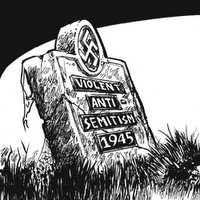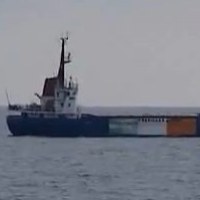![]()
Mon, Jan 23, 2012
This study was first published by The Meir Amit Intelligence and Terrorism Information Center: “The networks waging the campaign to delegitimize Israel are planning a series of propaganda displays for 2012, some of them in the upcoming months. They intend to hold marches (promoted by Hamas), a protest fly-in to Ben-Gurion International Airport, a flotilla and propaganda events for the ‘Israeli apartheid week.'”
Overview
After the campaign to delegitimize Israel had been waged successfully for two years (e.g., the Goldstone Report in 2009 and the Mavi Marmara flotilla in 2010), in 2011 Israel managed to contain it. Despite the intensive activities made by the networks involved in the campaign, their propaganda events (flotillas, a fly-in, the BDS[1] campaign, lawfare, etc.) were either failures or did not meet their full expectations.
An examination of the websites and public statements of individuals connected to the networks participating in the campaign reveals that despite their failure, they are still planning to challenge Israel, and to that end hold meetings to analyze the situation, learn the lessons of past failures and coordinate their next moves. The networks are aware that the campaign cannot be won in one battle, and therefore, they plan to make propaganda capital with a series of tactical events with high potential for media coverage.
Thus a number of propaganda events are planned for the upcoming months, the most prominent of which are marches originating in the Arab states bordering on Israel, and possibly also from the Palestinian Authority, to be held on or around the Israeli Arab “Land Day” (March 30); a protest fly-in to Ben-Gurion International Airport (April 15, a week after Easter); and the “Israeli apartheid week” in various Western and other countries, especially on college campuses (February and March). There are also plans to reach the Gaza Strip by sea with a large flotilla (the idea is still being examined) or with lone boats (logistically and politically easier to send than a large flotilla).
Beyond the showcase events, the delegitimization campaign’s routine anti-Israeli activities continue unabated, especially in the West (particularly Britain and the United States). They include the BDS campaign, which is gaining momentum and is waged in the Palestinian Authority as well; lawfare, manifested by the continuing attempts to bring senior Israeli figures to trial in Western countries and by possible appeals (lodged by both the delegitimization campaign and Palestinian Authority) to international legal forums such as the International Criminal Court and the International Court of Justice.
Of all the events, the most at this stage significant is the plan to hold marches from the Arab states to the borders of the State of Israel (mentioned were Jordan, Syria, Lebanon and Egypt, and the Palestinian Authority). Hamas activists in the Gaza Strip and Britain are also involved in the media preparations, among them Ismail Haniya and Mahmoud al-Zahar, who made a public appeal for people to march to the borders of Israel on “Land Day” to “forcefully push the Palestinian cause back [to center stage]” (YouTube). Muhammad Sawalha and Zaher Birawi, two prominent Hamas activists in Britain who are participating in the campaign to delegitimize Israel, also appeared in a video posted on YouTube to promote the marches (see below). In addition, Zaher Birawi gave an interview in which he represented himself as the spokesman for the “global march to Jerusalem” (GMJ) (Al-Quds TV, January 17, 2012). Hamas’ public involvement in the marches is exceptional because so far its public attention has focused on the land and sea convoys to the Gaza Strip.
The following is initial information about the various events currently being organized.
The March to the Borders of Israel (the So-Called “Global March to Jerusalem”)
Overview
Marches to the borders of the State of Israel are planned for March 30, 2012 (the day on which Israeli Arabs and Palestinians mark “Land Day”), calling them “the global march to Jerusalem.” The organizers of the marches plan to send groups from several countries to Arab states bordering on Israel. The participants will attempt to cross the border and invade Israeli territory. According to an open letter issued by the organizers, the marches will originate in Egypt, Syria, Lebanon and Jordan. Marches are also expected to originate in the Palestinian Authority. The organizers claim the marches will be “peaceful,” but past experience (the invasion through Majdal Shams in 2011, for example) has taught that they have the potential for violence.[2]
The objective of the marches, as stated by march spokesman Zaher Birawi and Ismail Haniya, head of the de-facto Hamas administration in the Gaza Strip (see below), is to raise public awareness regarding Jerusalem. Zaher Birawi said the marches were supposed to show Israel it had to end the “siege” of the Gaza Strip immediately and to show the world that “Palestine” and Jerusalem had to be “liberated.” He added that the idea to hold marches had been raised by various activists who had participated in the convoys to the Gaza Strip “to lift the siege” (Al-Quds TV, January 17, 2012).
In our assessment, at this stage there has not been much response, especially from activists in the West, but response may be greater as the date for the marches approaches. However, the organizers have to overcome the political obstacle of the permission of the various Arab states to hold the marches in their territories. Presumably, in the time remaining before the marches, the organizers, either directly or through local supporters organized into committees, will look for ways to obtain permission.[3]
Jordan
Jordan is one of the countries making preparations for the march. On January 13, 2012, the official Jordanian news agency issued a press release from Ahmed al-Armouti. chairman of the Jordanian doctors’ union and deputy chairman of the council of trade unions, stating that the trade unions had agreed in principle to participate in the march, which would originate on March 30 in four countries bordering on “Palestine” (mentioned were Jordan, Syria, Lebanon and Egypt). The participating Jordanian political parties and unions appointed a coordinating committee to liaise with “popular” and official elements in other countries bordering on Israel.
The Palestinian Authority and Israeli Arabs
A group is organizing in the Palestinian Authority to participate in the march. Its organizers are planning a series of “popular activities” which will begin in the middle of January and continue until the march begins (countercurrents forum website, January 11, 2012). It is also possible that Israeli Arabs will participate in the events as part of “Land Day” activities, as senior Hamas figure Mahmoud al-Zahar has called on the Palestinian people “in the occupied land” to participate (GM2J.com website).
Preparatory Meetings
In preparation for the marches a number of meetings have already been held in Jordan, India, Turkey and Italy. Others are planned for January, among them one in Beirut on January 17-18 which will be attended by 40 members of the global central committee for the marches, which represents committees all over the globe. They will discuss the organizational structure of the marches and the “popular activities” accompanying them (Global march website, January 15, 2012). On January 23 a meeting is scheduled for the Gandhi Peace Center in New Delhi (countercurrents forum website, January 11, 2012).
The first meeting, which was held in Amman, Jordan in December 2011, appointed a global central committee to manage the marches and a global advisory council. March 30, “Land Day,” was set as the march date (Hamas’ Al-Risala website, January 11, 2012).
Activists Involved in the Marches
Among those planning to participate in the marches are the following:
1) Zaher Birawi, the global march to Jerusalem spokesman, is a Hamas activist who lives in Britain. In the past he was active in organizing flotillas and convoys. He is chairman of the Palestine Return Centre’s (PRC) board of trustees in Britain (a delegitimization center specializing in the so-called “right of return”) and also has a key position in Al-Hiwar, the Muslim Brotherhood’s satellite channel which broadcasts from London.[4]
2) Muhammad Kazem Sawalha, formerly a senior Hamas operational operative in Judea and Samaria who fled to Britain in 1990. In Britain he conducts extensive anti-Israeli activities with organizations and networks affiliated with the Muslim Brotherhood. He is also involved in dispatching flotillas and convoys to the Gaza Strip (and was involved in preparations for dispatching the Mavi Marmara, claiming the “right” to confront “the Zionist enemy” on the high seas; however, he did not board the ship.) Sawalha openly supports anti-Israeli terrorism and violence in the Gaza Strip as part of the jihad waged by Islam around the globe.[5]
3) Feroze Mithiborwala, Indian anti-Israeli activist, was prominent in organizing the Asian march.[6] He maintains contact with other activists (such as Huwaida Arraf) and organizations participating in the campaign to delegitimize Israel (including involvement in BDS). He claims to have contacts with activists in Canada, the United States, Europe, Australia and the Arab world (YouTube.com).
4) Dr. Mazin Qumsieh is a Palestinian researcher and lecturer at both Bethlehem and Bir Zayit universities, is very active the campaign to delegitimize Israel (including involvement in BDS). He represents himself as a member of the monitoring committee for the global march to Jerusalem. He called on civil society organizations in Judea and Samaria to participate in the march regardless of their religious or political affiliations.
5) Paul Larudee is an American of Iranian extraction who lives on the West Coast and participated in various anti-Israeli activities in the territories (as part of the International Solidarity Movement — ISM) and in the flotilla project (where he participated in the Mavi Marmara flotilla).
6) George Galloway belongs to the extreme left, was formerly a British MP, participates in a wide variety of anti-Israeli activities within the delegitimization campaign. In a video posted on YouTube on January 8, 2012, he praised the marches which, he said, would “advance the return of the Palestinians to their homeland.” He said, with evident exaggeration, that hundreds of thousands and perhaps millions would march to Jerusalem through the Jordanian, Syrian, Egyptian and Lebanese borders.
On the program “The Real Deal,” broadcast by the Iranian Press TV station, George Galloway interviewed anti-Israeli Indian activist Feroze Mithiborwala. Mithiborwala claimed the objective of the marches was to raise world consciousness to Israel’s attempt to Judaize Jerusalem. He claimed that response to the campaign since it began in March 2011 was beyond their expectations (Press TV, January 11, 2012).
Hamas Involvement
Two senior Hamas figures, Ismail Haniya, head of the de-facto Hamas administration in the Gaza Strip, and Mahmoud al-Zahar recently issued public appeals for people to join the global march to Jerusalem on March 30. On December 14, 2011, Ismail Haniya gave a speech to mark the founding of Hamas, in which he called for the issue of Jerusalem to be put at the top of the Islamic nation’s priorities and appealed to his listeners to join the march to Israel’s borders on “Land Day.” That was to be done, he said, “to forcefully push the Palestinian cause back [to center stage]” (Al-Aqsa TV website and YouTube.com).

Left: Ismail Haniya speaks on December 14 on the occasion of the founding of Hamas and calls for participation in the marches (aqsatv.ps, youtube); Right: Mahmoud al-Zahar calls for participation in the marches to Jerusalem (GM2J.com website).
Muhammad Sawalha and Zaher Birawi, both Hamas activists, found asylum in Britain, and are active in the campaign to delegitimize Israel and participate in pre-march propaganda. Both appeared in a YouTube video posted by the march organizers. Muhammad Sawalha introduced himself (but did not speak), and Zaher Birawi introduced himself as a member of the international committee to break the siege of the Gaza Strip. He claimed the marches were a global effort to support the residents of “Palestine,” especially those living in Jerusalem, who were exposed to the Judaization of the city. On another occasion Zaher Birawi represented himself as march spokesman.

Left: Zaher Birawi in a YouTube video posted by the march organizers, introducing himself as a member of the International Campaign to End the Siege on Gaza; Right: Muhammad Sawalha in a YouTube video posted by the march organizers. He introduced himself but did not speak.
Hamas has recently emphasized the issue of Jerusalem to a great extent. Ismail Haniya, in his latest visits to Arab and Muslim countries emphasized the need for Arab -Muslim unity in view of what he claimed was the threat to Jerusalem and Al-Aqsa mosque. The emphasis on Jerusalem is evident in Hamas’ promotion of the marches. Its objective, in our assessment, is to find a common central theme which will unite the various Arab-Muslim political trends, and possibly an interest common to Hamas and Fatah in the internal Palestinian arena.
Conclusion
In our assessment, the organizers of the marches will seek to create a “popular” support base as well as to gain support from the governments of the countries bordering on Israel, which will enable them to receive permission to hold the marches. They will also exploit the governmental vacuum in Syria and seek support from the Muslim Brotherhood (nourished by Hamas’ public support) in countries like Jordan and Egypt. The Palestinian Authority campaign has as its objective to defame Israel and promote its concept of “popular resistance,” which can easily integrate into the March initiative.
However, the organizers may meet with resistance from the regimes in the various countries because the marches to the borders of Israel are liable to become uncontrollable and violent, as the marches in Syria did in 2011. In all probability, the organizers will contact the various Arab states and the Palestinian Authority, directly or through local organizations (e.g., the Muslim Brotherhood in Jordan and Egypt).
Dispatching Ships to the Gaza Strip

The logo of Freedom Flotilla Italia, an Italian network participating in organizing flotillas (Network website).
Learning Lessons of the Naval Events of 2011
On November 27, 2011, the international flotilla coalition gathered in Istanbul to hold its first official meeting since the Freedom Flotilla fiasco in Greece. The participants analyzed the causes of the failure to avoid making the same mistakes in the future. The main findings were the following (Freedom Flotilla Italy website, November 27, 2011):[7]
- Choosing to dispatch the boats from Greek ports did not take into consideration Greece’s weakness or its exposure to Israeli pressure, which induced Greece to prevent the ships from sailing from its ports.
- The media strength of the flotillas comes from their confrontation as unarmed civilian vessels with an armed military force [that is, the fact that they did to confront Israel made them less attractive to the media].
- One of their strengths lies in their ability to establish a non-partisan popular movement without government funding and/or a religious movement through nonviolent means [i.e., they can continue their activities without being subject governmental pressure].
- A main lesson for the future is not to concentrate all the vessels in one place and to dispatch them from different European ports.
Naval Activity, 2012
During 2012 lone ships will probably try to reach the Gaza Strip, obviating the necessity for an exceptional logistic-financial-political effort. At the same time, the coalition sending the flotillas is also apparently examining the possibility of sending a large flotilla from several different European ports.
The flotilla coalition’s planning committee has already held a number of meetings. The last was in Rome on December 11, and the next will be in Stockholm sometime this January, where the flotilla’s route will be chosen (Website of Freedom Flotilla Italia, January 3, 2012). The flotilla organizers are also busy raising donations for the funds necessary to purchase a large number of ships.

Raising funds for the flotilla on the Norwegian website (half a million Norwegian kroner equals about $85,000) (Flotilla website, January 15, 2012).
It is still not clear which networks will participate in the large-scale flotilla. Currently, there are plans for delegations from Italy, Canada, France, Greece, Malaysia, Holland, Norway, Spain, Sweden, Turkey and the United States. Reportedly, the networks behind the flotilla are the European Campaign to End the Siege on Gaza (ECESG)[8] and the International Campaign to End the Siege on Gaza (ICESG)[9] (Website of Freedom Flotilla Italia). However, other networks, such as the Free Gaza Movement, which specializes in flotillas, will probably later join the campaign.
Protest Fly-In to Ben-Gurion International Airport
The protest fly-in to Ben-Gurion International Airport is planned for April 15, 2012 (a week after Easter) and will be similar to the previous one. During December 2011 a number of preparatory meetings were held in France and Belgium. At one an attempt was made to raise donations to help activists pay for their plane tickets (Fly-in website, December 2011). In our assessment, so far response to the fly-in has been limited, but it will probably increase as the date approaches.
The objective of the fly-in was described by its organizers as challenging the “policy of isolation” Israel imposes on the West Bank. Fly-in participants have been requested to arrive at Ben-Gurion Airport but to keep a low profile, apparently to make it difficult for Israel to prevent them from entering the country (Fly-in website, January 15, 2012). Preparatory meetings were held in Paris on January 10 and in Brussels on January 13. Others are planned for Lyon on January 28 and Saint Denis on February 11.
The fly-in’s organizers expanded their activity to the social networks to recruit more volunteers than the number that participated last year. Some of the organizers who were interviewed stressed that the fly-in had to “take off in greater numbers.” They claimed that several hundred people had already responded, but that it was unclear how many of them would actually participate (Their Facebook page had 894 Likes as of January 15).
“Israeli Apartheid Week”
The “Israeli apartheid week” (IAW) is an international anti-Israeli event held every year in February and March on dozens of college campuses and other locations in Western countries.[10] IAW is part of the campaign to delegitimize Israel and its objective is to spread the narrative that Israel is an “apartheid state” and to encourage an international boycott (BDS) of the country. Despite the fact that the organizations involved in the delegitimization campaign represent the IAW as an event which attracts more and more people every year, in our assessment, so far its influence in Western countries is still limited.
This year, for the eighth consecutive year, events are planned for various days throughout February and March. In Europe they will take place in various countries between February 20 and March 10, in the Palestinian Authority between March 12 and 19, in the United States between February 26 and March 3, in Canada on March 29, and in the Arab world and South Africa between March 5 and 11 (IAW website, January 15, 2012). In our assessment the main events will be on campuses in Western countries, especially Britain and the United States.
![]()
Notes:
[1] Boycott, Divestment, Sanctions
[2] Salah al-Bardawil, head of Hamas’ information department, recently said in clarification that the so-called “popular resistance” (in relation to the argument between Hamas and the Palestinian Authority). He said it could be conducted at various levels which “depended on the level of public rage.” He said it might become violent and include the use of knives and cold weapons. He added that an intifada was also a form of “popular resistance” (Al-Sharq, January 15, 2012). In the past “popular resistance” events turned into violent confrontations.
[3] Marches spokesman Zaher Birawi was asked it there were governments which were unwilling to host the marches. He answered that they were not in contact with governments because it was a “popular action” and did not necessitate talking to governments. However, he added, popular committees in three key countries — Lebanon, Egypt and Jordan — were in constant contact with the regimes and various entities concerned with the matter (Al-Quds TV, January 16, 2012).
[4] The Palestine Return Centre (PRC) is an anti-Israeli propaganda center established in London in 1996. it is affiliated with Hamas and the Muslim Brotherhood, and several of its senior figures are Hamas operatives who found political asylum in Britain. The PRC was outlawed in Israel in 2010 as being the coordinating organizational arm of the Hamas movement in Europe. For further information see the March 8, 2011 bulletin: “The Palestinian Return Centre: anti-Israeli propaganda center affiliated with Hamas and the Muslim Brotherhood” by the ITIC.
[5] For further information see the February 21, 2010 bulletin “Britain as a Focus for Hamas’ Political, Propaganda and Legal Activities in Europe” by the ITIC.
[6] For further information see the December 12, 2010 bulletin “The Ideology Behind the Asia to Gaza Solidarity Caravan” by the ITIC.
[7] In our assessment, Israel’s early deployment played a significant part in the flotilla’s failure. Other contributing factor were the reservations of the international community regarding the flotilla project, which was regarded as provocation, and the support given by the international community and the Palmer Report to Israel’s right to impose a naval closure on the Gaza Strip.
[8] The ECESG is an anti-Israeli, pro-Hamas umbrella network founded in 2007. it includes several dozen networks and is active in Europe. Its activists participated in the Mavi Marmara flotilla.
[9] The ICESG is a network of Palestinian activists from Judea, Samaria and the Gaza Strip involved in the international campaign to lift the siege of the Gaza Strip.
[10] For further information about “Israel apartheid week in 2011, see the February 7, 2011 bulletin ““Israeli Apartheid Week”: Part of the Global Campaign to Delegitimize Israel” by the ITIC.



 RSS
RSS














[…] Supplement to the January 23, 2012 bulletin, “Anti-Israel Delegitimization Campaigns Continue Unabated” by the […]
Good article. This is also worth a read –
Manipulation and Deception: The Anti-Israel “BDS” Campaign
and
The Global March to Jerusalem: Part of the International Campaign to Delegitimize Israel